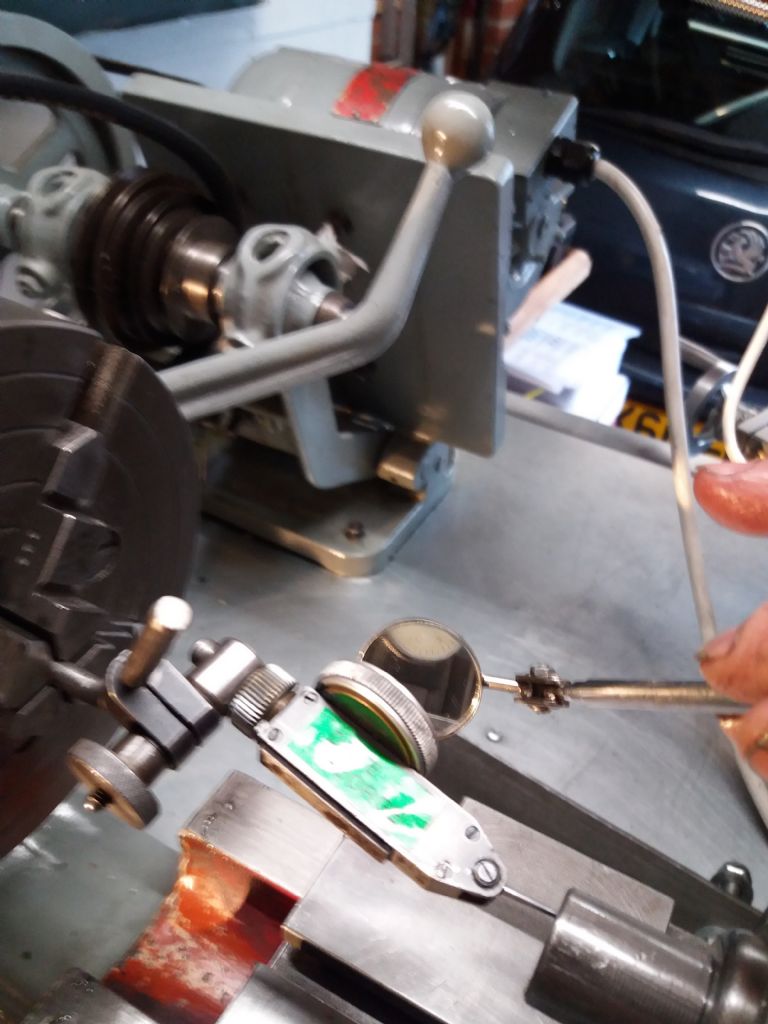Posted by Jon Halland on 05/10/2022 23:19:30:
…
Testing the bed: I've measured the width of the front bed that the carriage align to. Left from 0'' to 12'' in 1'' steps, all measurements using a 2'' micrometer are in the range 1.748''-1.749''. So max 0.001'' difference/wear, I guess that is fine?
Headstock Alignment: I got a new MT2 test bar (spec 0.001'' ) to do headstock alignment, mounted the carriage/apron tightly but still movable, using a dial indicator (0.0005'' resolution) I adjusted the headstock and tightened it down. With 0 and the start of the test bar I got 0.0015'' at 6''. But when turning the spindle I got 0.007'' run out – not good!
Test bar test: I marked the spindle and test bar and noted the spindle position, then moved the carriage with the dial indicator so I could turn the test bar 180 deg and repeat the test. Result 0.0075'' run out with the spindle in the same position. So the test bar is straight and within spec, which indicate the headstock spindle/bearings has 0.007'' run out.
I've shimmed and tightened the bearings to snug but turnable by hand.
How do I progress and test the spindle and bearings?
Edited By Jon Halland on 05/10/2022 23:20:23
The first thing you need to do is wait until 30 minutes or more after sunset when it is good and dark. Stand outside your workshop door and lick you finger and hold it up to determine which way the wind is blowing. Then throw that bloody test bar as hard and far in that direction as you can. Those things cause more problems than they solve, particularly in the sweaty hands of beginners.
And you need to separate headstock alignment from spindle runout. Two different things. Alignment is setting the lathe headstock and spindle in line with the lathe bed's central axis. Runout is the reading you get with a dial indicator when rotating something. If it is running eccentrically, you have runout.
A Myford headstock never needs realigning with the bed, under normal circumstances. It is done at the factory by trained fitters who set it up metal to metal, scraped to align it. No shims used.. If you return your headstock to its original position with the jacking bolts so the headstock metal is pressed up against the bed metal, it's aligned.
Now, if you want to set your lathe up to turn parallel (without a tailstock centre), do what we all do when all else fails: read the instructions. The Myford ML7 Users Manual gives a thorough run through on how to shim or adjust the lathe bed to bench mounting points to twist the bed slightly to make it turn parallel. You don't need to use a fancy level, and especially not a fancy test bar. It is done by taking test cuts over a piece of 1" diameter x 4" long steel bar and measuring the diameter at each end. You then shim or adjust the lathe bed feet at the tailstock end to make it turn parallel. Simple as anything. The ML7 User Manual is widely available for free download on the internet. It has all you need to know about aligning your headstock spindle to the bed.
On your million-year-old lathe, the internal Morse taper in the headstock spindle is almost certainly scarred up, butchered, abused or othewise out of whack enough to make it run out of true. And the spindle can even have developed a slight bend over the countless eons since is left Beeston. Mounting a fancy test bar in there tells you nothing, as you have found out.
Re your bed measurements, you are on the right track there, if you lathe is a pre-1972 narrow guide model that uses both vertical sides of the front way to guide the carriage. One thou of wear is very good. Three thou is Myford's recommended limit before regrinding. The thickness of that front way measured vertically is allowed a couple of thou more as it is less critical.
BUT, if your ML7 is post-1972 or has been converted to wide-guide configuration, it uses the front of the front way and the rear of the rear way, so you need a 4" micrometer to measure that overall distance to get a true reading of wear.
I thought I had a pic of that manual page on alignment to post but don't seem to be able to find it. But you can fiund the manual all over the net.EG the Myford lathes group on groups.io in the Files section.
Jon Halland.










